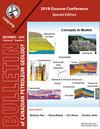白垩纪法医足部:在麦克默里地层滚动条上使用微电阻率图像日志跟踪大型游戏
Q3 Earth and Planetary Sciences
引用次数: 6
摘要
摘要首次描述了McMurray地层的地下滚动条设置。它由山脊和洼地组成,覆盖点砂坝矿床。在同一狭窄的地层带中,涡旋条状物要么表现为与山脊相对应的低角度垂向剖面,要么表现为沉积在洼地中的平坦层理。这些特征是在洪水事件期间从悬浮中沉积下来的;一组脊的方向平行于点坝的发展,而上覆在第二点坝上的脊的方向是倾斜的。斜脊的方位局部受河流超高标高控制。最近解释的深达60厘米、宽达50厘米的垂直加载结构被解释为恐龙脚印。这些脚印被限制在滚动条的相关山脊和洼地设置的点坝上方的狭窄地层带内。这是在麦克默里组发现的第一批恐龙脚印,也是第一批通过图像日志进行解释的恐龙脚印。尽管这些足迹是在映像日志中识别的,但是映像日志特性现在允许在核心中识别足迹。滚动条和恐龙脚印分别为McMurray组的洪泛平原环境提供了直接证据,但结合起来提供了令人信服的地下环境和完整的点条-滚动条循环的文件。这一新的解释扩展了未来McMurray组测绘的沉积框架。本文章由计算机程序翻译,如有差异,请以英文原文为准。
Cretaceous forensic podiatry: big game tracking with a microresistivity image log on a McMurray Formation scroll bar
Abstract For the first time, a subaereal scroll bar setting is described for the McMurray Formation. It is made up of ridge and swale features capping point bar deposits. Occurring in the same narrow stratigraphic zone, scroll bars appear as either a vertical section of low-angle dips corresponding to ridges, or flat-lying bedding deposited in swales. These features were deposited from suspension during flooding events; the orientation of one set of ridges parallels point bar development, while the ridges overlying a second point bar are oriented obliquely. The orientation of the oblique ridges was locally controlled by superelevation of the river. Newly interpreted vertical loading structures up to 60 cm deep and 50 cm across are interpreted to be dinosaur footprints. These footprints are limited to a narrow stratigraphic zone above the point bars in the associated ridge and swale setting of the scroll bar. These are the first dinosaur footprints discovered in the McMurray Formation and the first to be interpreted from image logs. Although these footprints were identified in image logs, the image log features now permit the identification of footprints in core. The scroll bars and dinosaur footprints each provide direct evidence for a floodplain environment in the McMurray Formation, but combined provide compelling documentation of a subaereal setting and the complete point bar –scroll bar cycle. This new interpretation expands the depositional framework for future mapping in the McMurray Formation.
求助全文
通过发布文献求助,成功后即可免费获取论文全文。
去求助
来源期刊

Bullentin of Canadian Petroleum Geology
Earth and Planetary Sciences-Geochemistry and Petrology
CiteScore
2.50
自引率
0.00%
发文量
0
期刊介绍:
The Bulletin of Canadian Petroleum Geology is a peer-reviewed scientific journal published four times a year. Founded in 1953, the BCPG aims to be the journal of record for papers dealing with all aspects of petroleum geology, broadly conceived, with a particularly (though not exclusively) Canadian focus. International submissions are encouraged, especially where a connection can be made to Canadian examples.
 求助内容:
求助内容: 应助结果提醒方式:
应助结果提醒方式:


